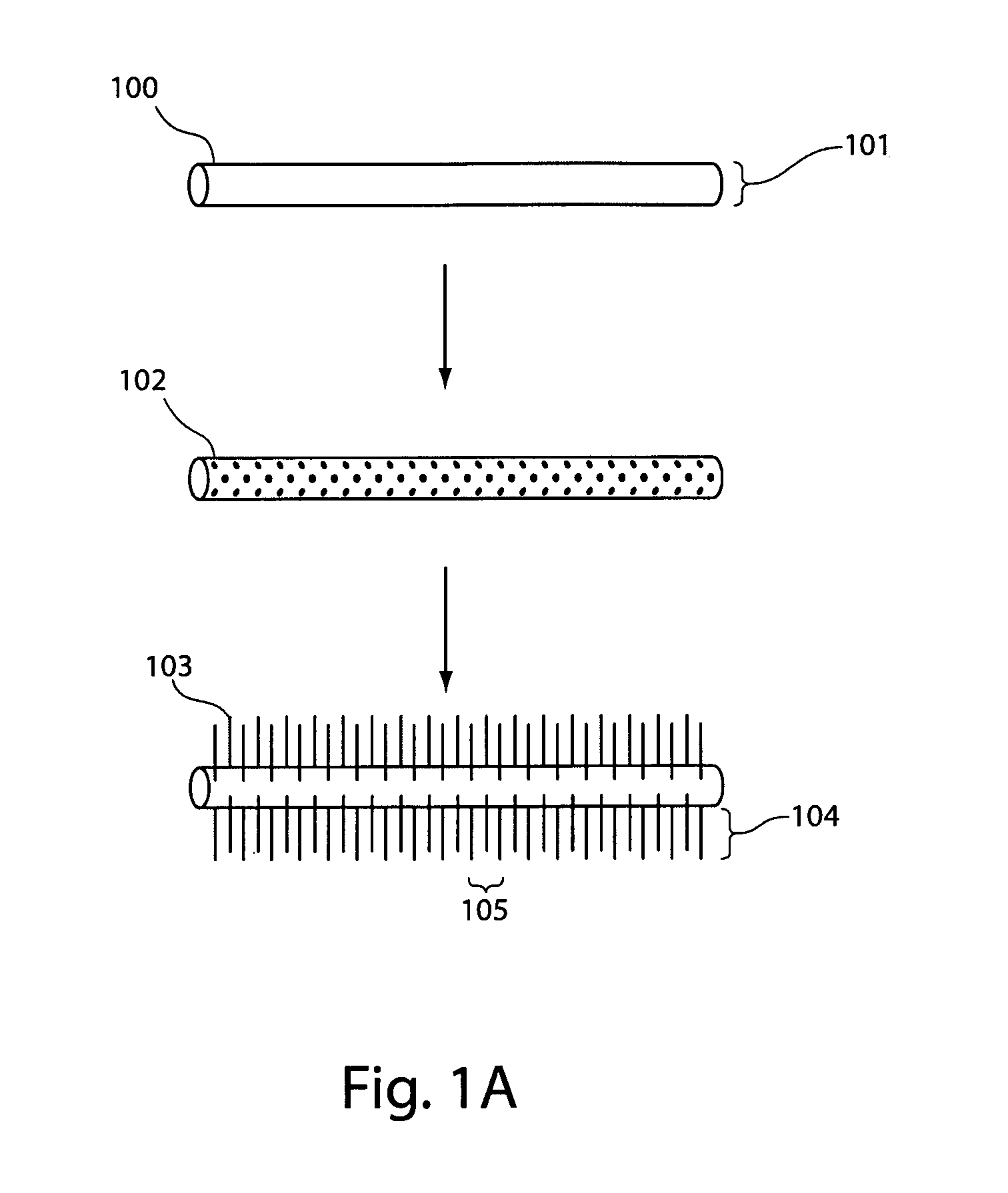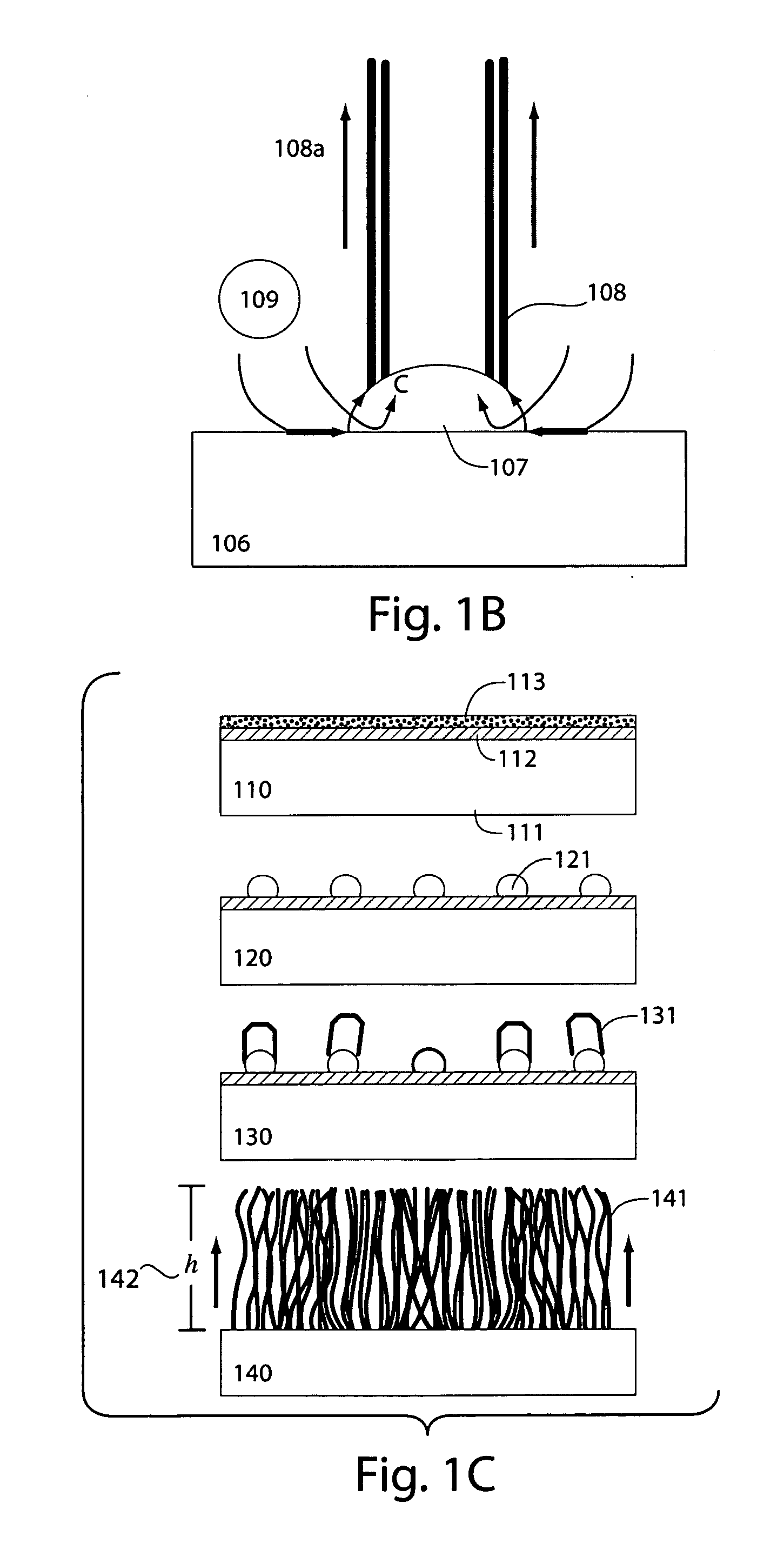Nanostructure-reinforced composite articles and methods
a technology of nanostructures and composite articles, applied in the field of nanostructure synthesis and processing, can solve the problems of poor alignment of cnt axes, dispersion of cnts in secondary materials, and hindered by cnt agglomeration
- Summary
- Abstract
- Description
- Claims
- Application Information
AI Technical Summary
Benefits of technology
Problems solved by technology
Method used
Image
Examples
example 1
[0163] The following example describes an exemplary process for growing layers of aligned carbon nanotubes on a substrate. A patterned catalyst film of 1 / 10 nm Fe / Al2O3 was deposited on a plain (100) 6″ silicon wafer (p-type, 1-10-cm, Silicon Quest International, which was cleaned using a standard “piranha” (3:1 H2SO4:H2O2) solution) by e-beam evaporation in a single pump-down cycle using a Temescal VES-2550 with a FDC-8000 Film Deposition Controller. The catalyst pattern was fabricated by lift-off of a 1 μm layer of image-reversal photoresist (AZ-5214E), which was patterned by photolithography. The catalyst was deposited over the entire wafer surface, and the areas of catalyst that were deposited on the photoresist were removed by soaking in acetone for 5 minutes, with mild sonication. The film thickness of the catalyst was measured during deposition using a quartz crystal monitor and was later confirmed by Rutherford backscattering spectrometry (RBS).
[0164] CNT growth was perform...
example 2
[0169] The following examples describes the production of ceramic fibers containing carbon nanotubes on the surface of the fibers. Fiber strands were cut from a commercially-available (McMaster-Carr) aluminum oxide (Al2O3) fiber cloth and soaked for five minutes in a 10 mM solution of Fe(NO3)3•9H2O in isopropanol (prepared by stirring and sonication). The fiber strands were then allowed to dry in air. FIG. 15 shows SEM images of the Al2O3 fibers loaded with the iron catalyst material on a (a) 100 micron and (b) 20 micron scale. The Al2O3 fibers were about 20 μm in diameter, each strand comprising several hundred fibers. Carbon nanotube growth was performed using a single-zone atmospheric pressure quartz tube furnace (Lindberg) having an inside diameter of 22 mm and a 30 cm long heating zone. Flows of Ar (99.999%, Airgas), C2H4 (99.5%, Airgas), and H2 (99.999%, BOC) were measured using manual needle-valve rotameters. The furnace temperature was held at 750° C., with 100 / 500 / 200 sccm ...
example 3
[0173] The following example describes the production of composite thin films containing vertically-aligned carbon nanotubes. A pattern of rectangular “pillars” containing carbon nanotubes was grown on a silicon wafer, according to the process described in Example 1. The carbon nanotubes were vertically-aligned and substantially perpendicular to the substrate, and were held together in the form of pillars by surface forces. By adjusting the either the concentration of C2H4 in the reaction chamber or the reaction temperature, it was possible to control the growth rate and height of the carbon nanotube pillars. In this example, the carbon nanotube height was measured to be 100 μm.
[0174] The carbon nanotubes on the silicon wafer were then combined with a second substrate to form a composite thin film. A fast-curing (e.g., 20 minute) room-temperature conductive epoxy was deposited on a glass substrate (e.g., the “second” substrate) in the form of a thin film having a thickness approxim...
PUM
| Property | Measurement | Unit |
|---|---|---|
| Fraction | aaaaa | aaaaa |
| Fraction | aaaaa | aaaaa |
| Fraction | aaaaa | aaaaa |
Abstract
Description
Claims
Application Information
 Login to View More
Login to View More - R&D
- Intellectual Property
- Life Sciences
- Materials
- Tech Scout
- Unparalleled Data Quality
- Higher Quality Content
- 60% Fewer Hallucinations
Browse by: Latest US Patents, China's latest patents, Technical Efficacy Thesaurus, Application Domain, Technology Topic, Popular Technical Reports.
© 2025 PatSnap. All rights reserved.Legal|Privacy policy|Modern Slavery Act Transparency Statement|Sitemap|About US| Contact US: help@patsnap.com



